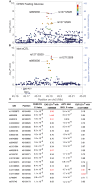Identification and functional analysis of glycemic trait loci in the China Health and Nutrition Survey
- PMID: 29621232
- PMCID: PMC5886383
- DOI: 10.1371/journal.pgen.1007275
Identification and functional analysis of glycemic trait loci in the China Health and Nutrition Survey
Abstract
To identify genetic contributions to type 2 diabetes (T2D) and related glycemic traits (fasting glucose, fasting insulin, and HbA1c), we conducted genome-wide association analyses (GWAS) in up to 7,178 Chinese subjects from nine provinces in the China Health and Nutrition Survey (CHNS). We examined patterns of population structure within CHNS and found that allele frequencies differed across provinces, consistent with genetic drift and population substructure. We further validated 32 previously described T2D- and glycemic trait-loci, including G6PC2 and SIX3-SIX2 associated with fasting glucose. At G6PC2, we replicated a known fasting glucose-associated variant (rs34177044) and identified a second signal (rs2232326), a low-frequency (4%), probably damaging missense variant (S324P). A variant within the lead fasting glucose-associated signal at SIX3-SIX2 co-localized with pancreatic islet expression quantitative trait loci (eQTL) for SIX3, SIX2, and three noncoding transcripts. To identify variants functionally responsible for the fasting glucose association at SIX3-SIX2, we tested five candidate variants for allelic differences in regulatory function. The rs12712928-C allele, associated with higher fasting glucose and lower transcript expression level, showed lower transcriptional activity in reporter assays and increased binding to GABP compared to the rs12712928-G, suggesting that rs12712928-C contributes to elevated fasting glucose levels by disrupting an islet enhancer, resulting in reduced gene expression. Taken together, these analyses identified multiple loci associated with glycemic traits across China, and suggest a regulatory mechanism at the SIX3-SIX2 fasting glucose GWAS locus.
Conflict of interest statement
The authors have declared that no competing interests exist.
Figures




References
-
- World Health Organization. Gobal Report on Diabetes. 2016.
-
- Ma RC, Chan JC. Type 2 diabetes in East Asians: similarities and differences with populations in Europe and the United States. Annals of the New York Academy of Sciences. 2013;1281:64–91. doi: 10.1111/nyas.12098 - DOI - PMC - PubMed
-
- Fuchsberger C, Flannick J, Teslovich TM, Mahajan A, Agarwala V, Gaulton KJ, et al. The genetic architecture of type 2 diabetes. Nature. 2016;536(7614):41–7. doi: 10.1038/nature18642 - DOI - PMC - PubMed
-
- Mahajan A, Wessel J, Willems S, Zhao W, Robertson NR, Chu AY, et al. Refining The Accuracy Of Validated Target Identification Through Coding Variant Fine-Mapping In Type 2 Diabetes. bioRxiv. 2017. doi: 10.1101/144410 - DOI - PMC - PubMed
-
- Mohlke KL, Boehnke M. Recent advances in understanding the genetic architecture of type 2 diabetes. Human molecular genetics. 2015;24(R1):R85–92. doi: 10.1093/hmg/ddv264 - DOI - PMC - PubMed
Publication types
MeSH terms
Substances
Grants and funding
- P30 ES010126/ES/NIEHS NIH HHS/United States
- R01 HD038700/HD/NICHD NIH HHS/United States
- R01 HD030880/HD/NICHD NIH HHS/United States
- T32 GM067553/GM/NIGMS NIH HHS/United States
- R01 DK072193/DK/NIDDK NIH HHS/United States
- U01 DK105561 /NH/NIH HHS/United States
- T32-HL129982 /NH/NIH HHS/United States
- R01 GM060500/GM/NIGMS NIH HHS/United States
- D43 TW007709/TW/FIC NIH HHS/United States
- D43 TW009077/TW/FIC NIH HHS/United States
- DK056350 /NH/NIH HHS/United States
- R01-HD38700/NH/NIH HHS/United States
- R01-HD30880/NH/NIH HHS/United States
- T32 HL129982/HL/NHLBI NIH HHS/United States
- R01 HL108427/HL/NHLBI NIH HHS/United States
- T32GM67553 /NH/NIH HHS/United States
- T32 HD007168/HD/NICHD NIH HHS/United States
- P30 DK056350/DK/NIDDK NIH HHS/United States
- U01 DK105561/DK/NIDDK NIH HHS/United States
- R24 HD050924/HD/NICHD NIH HHS/United States
- R01 DK072193 /NH/NIH HHS/United States
- P2C HD050924/HD/NICHD NIH HHS/United States
LinkOut - more resources
Full Text Sources
Other Literature Sources
Medical

